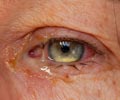- Orbital cellulitis - (https://medlineplus.gov/ency/article/001012.htm)
- More Information On Orbital cellulitis - (https://eyewiki.aao.org/Orbital_Cellulitis)
- All You Need To Know About Orbital cellulitis - (https://en.m.wikipedia.org/wiki/Orbital_cellulitis)
- The Hot Orbit: Orbital Cellulitis - (https://www.ncbi.nlm.nih.gov/pmc/articles/PMC3277022/)
- Cellulitis, preseptal and orbital - (https://www.college-optometrists.org/guidance/clinical-management-guidelines/cellulitis-preseptal-and-orbital.html)
- Learn More About Orbital cellulitis - (https://www.mountsinai.org/health-library/diseases-conditions/orbital-cellulitis)
What is Orbital Cellulitis?
Orbital cellulitis is an inflammation and infection of the soft tissue, in the posterior part of eye socket. It generally refers to bacterial infection of fat and muscles around the eye, which could have spread from blood, paranasal sinuses or skin. It could also result due to trauma or insect bite.
Although it may occur at any age, it is usually seen in young children. It generally affects eyelids, eyebrows and cheeks. Orbital cellulitis infections in children can get worse and lead to blindness. Treatment may require hospitalization and parenteral antibiotics.
It is important to consult a healthcare provider if any of these symptoms are apparent. If not treated immediately, it can lead to permanent loss of vision or even death.
What are the Causes of Orbital Cellulitis?
Orbital cellulitis is generally caused by pathogenic bacteria like Staphylococcus aureus and Streptococcus pneumoniae.
The risk factors which could cause orbital cellulitis include:
- Bacterial sinusitis
- Upper respiratory tract infection
- Periocular or ocular infection
- Trauma to eye
- Systemic infections
- Immunosuppression (reduced immunity and increased risk of infections)
- Rarely as a complication of eye surgery or impaction of foreign object within the eye









